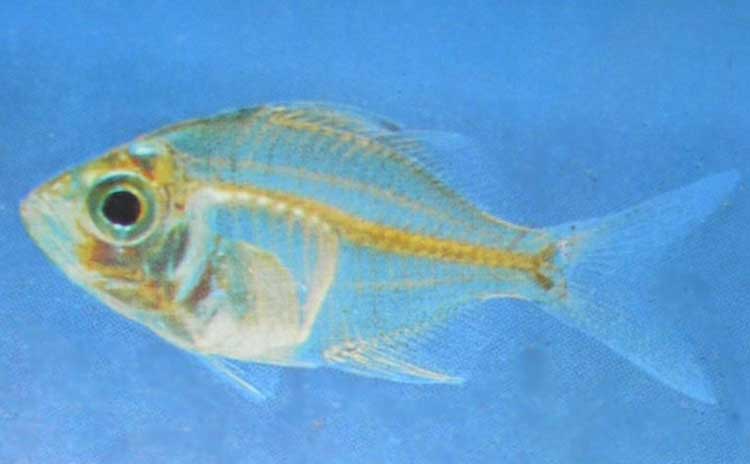Parambassis ranga Cladus: Eukaryota --------- The Indian glassy fish, Parambassis ranga, is a species of freshwater fish in the Asiatic glassfish family (family Ambassidae) of order Perciformes. It is native to an area of south Asia from Pakistan to Malaysia. The Indian glassy fish has a striking transparent body revealing its bones and internal organs; the male develops a dark edge to the dorsal fin. The fish grows to a maximum overall length of 80 millimetres (3.1 in). It occurs in standing water, especially in impoundments, and it breeds prolifically during the rainy season. The species feeds on crustaceans, annelid worms, and other invertebrates. It is in turn prey for larger fish, including snakeheads (family Channidae). The Indian glassy fish is not important as a food fish for humans, but is very common in the aquarium trade. Formerly classified as Chanda ranga, the species is also known as the Indian glassfish, Indian glass perch, and Siamese glassfish. In the aquarium These fish can be shy when kept in too small a group (fewer than five individuals) but when more fish are kept, they become bold and outgoing, making interesting additions to the community tank. They prefer to swim at the middle and lower levels of the tank, and will take most small live and frozen foods. In general, they tend not to eat dried foods (such as flake) [2]. The fish reproduce by laying the eggs (females) and then the males fertilise the eggs Dyed glassfish, or "disco fish" Indian glassy fish sold to hobbyists have often been "painted", which involves injecting coloured dye into the fish's transparent tissue to make them more attractive to hobbyists [3]. These coloured fish are often called "disco fish". Inexperienced fishkeepers are often tricked into believing such fish are natural or that the process is painless and causes no harm [4]. Fish thus treated have suffered trauma and are susceptible to disease, including ich, fin rot and the viral disease Lymphocystis. The artificial coloration often fades within a short time. Healthy, non-"painted" specimens may live three to four years in captivity, but such individuals may be difficult to find in some localities. References 1. ^ Schäfer, Frank 2005. Brackish-Water Fishes, Aqualog. ISBN 3-936027-82-X (English), ISBN 3-936027-81-1 (German) * Froese, Rainer, and Daniel Pauly, eds. (2004). "Parambassis ranga" in FishBase. October 2004 version. Source: Wikispecies, Wikipedia: All text is available under the terms of the GNU Free Documentation License |
|

